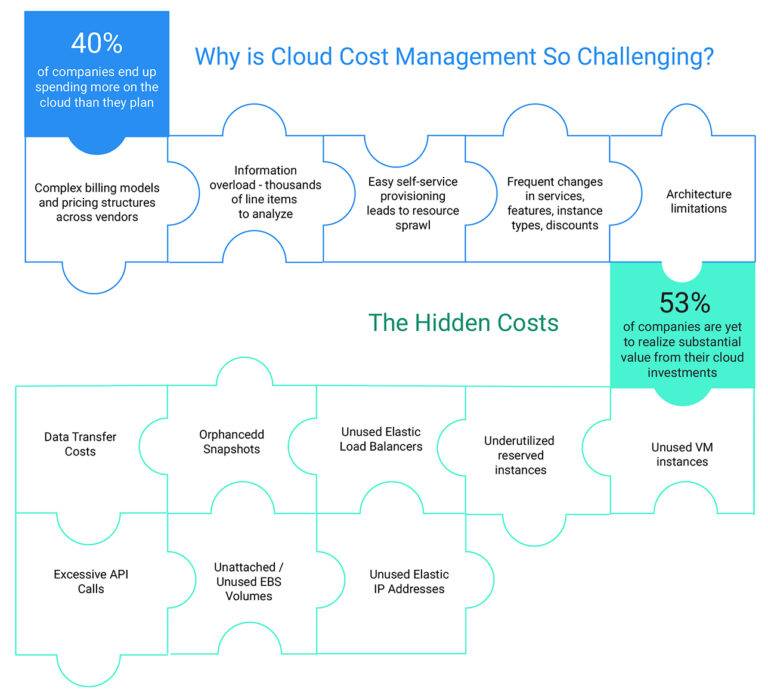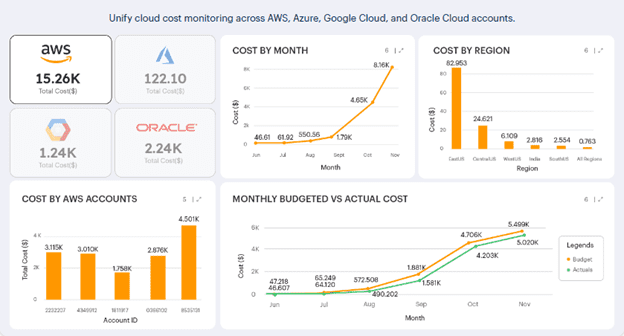- July 28, 2023
- Posted by: Abishek Balakumar
- Category: Industries

ALERT! ENTERPRISES DEMAND MORE DISCIPLINE WITH CLOUD COSTS (A wake-up call for businesses)
Cloud costs comprise about 20% of IT spending, and no one wants a shockingly high bill.
As managing cloud expenses grows, companies increasingly emphasize optimizing their cloud expenditure. According to Global Industry Analysts spending on public cloud services is expected to reach around $800 billion by 2027. However, managing costs is tricky because assets are scattered across different clouds, and most solutions only offer reactive monitoring. It’s time to bridge the gap between cost control and business success. Having a robust cloud strategy is of the utmost importance, and fintech organizations like Indium Software can assist you in managing and developing the right strategy for your cloud needs. Read how Indium can assist.
FinOps for Cloud Cost Optimization & Multi-Cloud Cost Monitoring
You have undoubtedly gotten that CALL from the CFO, Finance team, and the money inspectors from the management inquiring about your monthly cloud spending if you’ve managed a cloud data platform. And it usually comes like this:
1. Seriously, what on earth is happening with our cloud usage? Did someone leave a money faucet open?
2. Are we just flushing money down the drain with this cloud service? Did a bunch of spendthrifts infiltrate our company overnight?
3. Why is our cloud costs out of control? Do we have predictive analytics tools or solutions available to help forecast our future cloud costs?
And trailed by too many French and Latin words!
Challenges in one infographic!

FinOps is like having a financial guru for your cloud expenses. It helps you keep track of all your cloud assets and manage them from one place. You can monitor your cloud usage and see where your money is going. Predictive data analysis by co-relating cost, revenue, and business metrics assists customers in achieving unit economics and understanding how specific units and/or customers impact cloud metrics, including cost, utilization, and performance! Using FinOps, businesses can save a ton of money, around 40% to 50%, 99.95% Uptime, and 100% accurate cost center mapping, according to Gathr, while making better plans and budgets.
1. Inform: Get real-time visibility of your cloud costs and understand what’s driving them. See a detailed breakdown of your spending patterns, allocations, budgets, forecasts, and analytics.
2. Optimize: Use the insights from the “inform” phase to make intelligent adjustments. Fine-tune your configurations, find and eliminate underutilized services, uncover potential discounts, and compare costs across different workloads.
3. Operate: Put your goals into action. Share spend data with stakeholders, optimize instance sizes, establish cloud governance, and automate processes. Make cloud operations integral to your design and development, ensuring a robust and cost-effective system. Implement governance mechanisms to monitor your cloud infrastructure, estimate costs, and conduct continuous audits.
Multi-Cloud Cost Monitoring allows organizations to effectively track and manage their cloud expenses across multiple cloud platforms such as AWS, Azure, GCP, and Oracle Cloud. With Predictive Analytics for Cloud Cost Optimization!

Source: Gathr
What else do you need apart from this dashboard? Predictive Analytics > Model Building > Predictive Model > Real-Time Prediction! Read about data visualization here.
Just transform your cloud spending landscape! Our out-of-the-box cloud cost optimization solution provides enterprises with the following:
1. Unified multi-cloud cost visibility: Monitor and compare costs across AWS, Azure, Google Cloud, and Oracle Cloud in one place.
2. Granular visibility into cloud costs: Analyze costs by regions, instances, top services, resources, and operations.
3. Tag compliance: Monitor and improve cost attribution with easy visibility into tagged and untagged resources.
4. Advanced alerts & recommendations: Receive alerts for budget exhaustion, costly instances, and anomalies, with customizable thresholds and integration with enterprise tools.
5. Improved cloud operations and ROI: Optimize containerized workloads, monitor Infra as Code pipelines, and streamline Kubernetes applications for increased automation and observability.
Predictive analysis can be useful for banks to predict customer behavior and preferences. This can help decide what products can be sold to which category of customers and help improve customer experience. It can also predict market fluctuations which help organizations address issues at the right time to get the best outcome. Predictive analysis can also help prevent fraudulent transactions by blocking suspicious access to a customer’s account. Based on customer credit scores, it can predict which customers are likely to miss payments and whom to lend money to, and it plays a significant role in gaining a competitive advantage and helps in better decision-making. Read here
Where to go from here?
All of the above are crucial for effective cost control, regardless of whether you utilize third-party tools, your CDP’s features, a customized set of services, or a combination. It’s rare to find a single solution that solves every problem. I highly recommend forming your team to put the right resources in place to monitor, surface, and optimize cloud costs and usage.
The next time you have a conversation with the CFO, they might say, “Fantastic job! Look at the money we saved this month!”




